Whilst old wallpaper might be a reason for many to renovate a room, older properties often have valuable and unique designs that benefit from professional conservation. If it is not already on display, antique wallpaper is often uncovered during an interior restoration. As tastes have changed, decorative elements are often hidden by new owners, who are unknowingly removing an important part of British design history.
 Above: various wallpapered interiors in historic houses
Above: various wallpapered interiors in historic houses
The idea that wallpaper is a lesser decorative art has changed in recent years. Preserving the visual history of a home has become evermore important to owners, who aim to restore a property as authentically as possible. Reversing past intervention is a complex process, ensuring the paper is preserved in full or in fragments. The result allows a building to recover its cultural value and provide those living within it with a true sense of their home’s past.
 Above: fragments of wallpaper from the 18th and 19th centuries
Above: fragments of wallpaper from the 18th and 19th centuries
Paper is a sensitive medium, its widespread use in an interior creates a vulnerable layer that can be easily disturbed by water, sunlight and adhesives. It can also harbour dangerous historic materials that require caution and expert advice. This article will look into the history and aesthetic value of historic wallpaper, as well as how to conserve it for future generations.
 Above: a mid 19th century interior with papered walls
Above: a mid 19th century interior with papered walls
Wallpaper history
Interior decoration has developed over hundreds of years, through the application of murals, tapestries and gold leaf. The artistic choice often reflects the social status of the owner, from the celestial grandeur of baroque palaces to the domestic appeal of Victorian terraces. The advancement of wallpaper was dependent on new technology, with the earliest examples in Europe dating to the 16th century and the advent of paper making in the west. From its beginning, wallpaper was seen as a more affordable and effective means of decorating a room.
 Above: designs from a 16th century pattern book by Matteo da Treviso, 1532
Above: designs from a 16th century pattern book by Matteo da Treviso, 1532
Originally created on a small scale due to the limitations of print-making, interior paper was used to line furniture or displayed as a single wall hanging. This early paper was decorated with wooden blocks and stencils or hand-painted. The ink sometimes had additives to avoid deterioration and insect infestation, allowing it to survive for centuries. Early print-makers produced engravings with the intention of them being pasted onto a wall; these designs could be created across hundreds of sheets to produce a large scale diorama.
 Above: a selection of 17th century and early 18th century wall coverings
Above: a selection of 17th century and early 18th century wall coverings
The earliest example of wallpaper in England is dated to 1509. Discovered in Christ’s College Cambridge, it was a black and white print featuring pomegranates. Wallpaper pigments were fairly limited until the end of the 18th century. Early wallpapers used organic dyes such as ochre, vermillion, blue, green, indigo and rose pink. Due to their natural properties, these inks were very prone to fading in sunlight and many of the examples surviving today are not as bright as they would have originally appeared. To prevent this deterioration, some wallpapers were coated in varnish. Over time, this varnish has usually yellowed and darkened.
 Above: oil paintings depicting 18th century interiors, these wall designs would have been printed on paper or textiles
Above: oil paintings depicting 18th century interiors, these wall designs would have been printed on paper or textiles
Wallpaper decorated the homes of English aristocrats from the Tudor period onwards, ceasing for a short time during the English civil war before being revived in the court of Charles II. In 1712, Queen Anne introduced a wallpaper tax, ensuring every piece was taxed to the equivalent of £3.80 per square yard. This tax continued to exist until the 1830s, ensuring that wallpaper was reserved for the upper classes who could afford such a luxury. The duty stamp on the reverse of wallpaper between these dates is a helpful tool for accurately ageing paper today.
 Above: a room from the Powel House in Philadelphia, remodelled with Chinoiserie wallpaper in 1769-71
Above: a room from the Powel House in Philadelphia, remodelled with Chinoiserie wallpaper in 1769-71
During the 18th century, the fashion for Chinese art and crafts had great influence on the production of wallpaper. Hand painted designs were shipped from Asia as early as the 17th century, featuring scenes from everyday life or botanical elements – often peonies, branches, butterflies and birds. These sensitive papers were formed from rice and bamboo, sometimes silky in appearance due to an inclusion of mica powder. This medium makes original Chinese wallpaper prone to breakage, fading and severe deterioration.
 Above: three rococo wallpapers with designs inspired by Asian art
Above: three rococo wallpapers with designs inspired by Asian art
Flocked wallpapers were developed in the late 17th century and were fashionable by the 1730s. These often feature a damask repeat pattern, inspired by more expensive velvet pieces. The effect of flocking was achieved by the application of wool fibres, a by-product of the wool trade that was essentially a powdered textile. Flocking was adhered using turpentine, preventing it from moth infestations. Trompe l’oeil designs were used in some wallpapers to create a ‘mock flock’ appearance.
 Above: two 19th century rooms with wallpaper decoration
Above: two 19th century rooms with wallpaper decoration
The continuous roll of wallpaper that we know today was invented in the 1830s, allowing wallpaper to be produced on an industrial scale by the mid 19th century. This also allowed wallpaper to become easily accessible to those outside of the aristocracy, with the Victorian middle classes being affluent enough to decorate their homes with elaborately patterned papers. In England, the production of wallpaper in 1834 was around one million rolls a year, by 1860 this had risen to almost nine million rolls.
 Above: an illustration showing the process of wallpaper production, 1882
Above: an illustration showing the process of wallpaper production, 1882
As a response to the industrial revolution, William Morris and the craftsmen of the ‘arts and crafts’ movement created hand-made designs with a focus on nature and pre-Raphaelite themes such as mediaeval art. Morris and Co. famously produced over 60 block printed designs, many of which are still popular today.
 Above: various wallpaper designs from the studio of William Morris
Above: various wallpaper designs from the studio of William Morris
By the mid 20th century, wallpaper was a mainstream way of decorating your home, regardless of your wealth and status. Whilst the inks and manufacturing involved in wallpaper production was halted during the second world war, it was revived in great fashion for mid century modern interiors.
 Above: detail of an early 20th century wallpaper
Above: detail of an early 20th century wallpaper
Historic wallpaper dangers
Infamously, some historic wallpaper was dyed green through the use of arsenic. Scheele’s Green or Schloss Green and Paris Green or Vienna Green are used on a variety of historic products, including children’s toys. The dangers of its ingredients were discovered in the 1860s and it diminished in use by the end of the 19th century due to health concerns. If you discover green wallpaper decoration during your renovation, contact an experienced conservator immediately for advice.
 Above: wallpaper dated to 1881-82
Above: wallpaper dated to 1881-82
Other chemicals found in historic wallpaper prints include cyanide, mercury, lead, chromium, cadmium, and antimony. If you think some of these may be evident, ensure that protective measures are put in place to avoid the inhalation of dust particles.
 Above: watercolour painting of a Victorian interior
Above: watercolour painting of a Victorian interior
Flocking has often allowed wallpaper to survive for centuries, however the woollen fibre material can be dangerous if it is weak and airborne. A disease known as flock worker’s lung is caused by breathing in these irritable particles. We recommend that such wallpaper is assessed, cleaned and stabilised by an expert using a face mask and protective glasses to avoid any health issues.
 Above: detail of flocked wallpaper from 1920
Above: detail of flocked wallpaper from 1920
Identifying historic wallpaper
Historic wallpaper was created with the inclusion of recycled textiles, adding extra strength with linen and cotton fibres. Different materials were included at various dates, allowing conservators to analyse and date samples through pigment and material analysis.
 Above: a selection of 19th century wallpapers and interior designs
Above: a selection of 19th century wallpapers and interior designs
The mould used to make early wallpaper involved a brass mesh, this was later replaced with a finer gauze allowing paper to appear much smoother. This development allows us to decipher whether a paper was created before or after 1750.
 Above: a wallpaper frieze dated 1905-1915
Above: a wallpaper frieze dated 1905-1915
Wallpaper may also have a stamp mark on the reverse. These were often included between 1712 and 1836 due to the wallpaper tax introduced by Queen Anne.
 Above: fragments of mid 19th century wallpaper
Above: fragments of mid 19th century wallpaper
If you are uncertain about the era of the wallpaper you uncovered, the Wallpaper History Society is open to questions via their Instagram account.
 Above: detail from a neoclassical wallpaper panel that has darkened with age, 1790
Above: detail from a neoclassical wallpaper panel that has darkened with age, 1790
Wallpaper restoration
The conservation of wallpaper can be completed in-situ or in a studio setting, depending on whether it is still part of the building’s interior. Our team has restored wallpaper panels and fragments, allowing them to be preserved and displayed as artworks in their own right.
 Above: a fragment of 18th century wallpaper
Above: a fragment of 18th century wallpaper
Typically, wallpaper requires sensitive cleaning to remove the build up of historic dirt, dust and contaminants. Old properties would have had open fireplaces, so the surface of the walls will almost certainly have some level of acidic soot particles. Overtime, a home may have also faced various damages and disasters – most often an escape of water through the ceiling or walls, causing a water stain to the paper and surrounding decoration. Water and fire damage can be sensitively cleaned and stabilised to allow for the continued display and protection of affected decoration.
 Above: a wallpaper fragment, before and after conservation by our team
Above: a wallpaper fragment, before and after conservation by our team
Torn and deteriorating paper is a frequent reason for professional restoration. Left unstabilised, tears may become worse and lead to more widespread damage. Our paper conservator can sensitively restore damaged areas, using techniques that add extra strength to the weakened joins. If the wallpaper has been taken down, the fragments and panels can be lined on a non-acidic Japanese tissue paper to add further protection. Below is an example of a Chinese wall panel that required consolidation of the torn areas, as well as cleaning and lining onto tissue paper.

Wallpaper with dangerous particles can be placed in a frame or behind a protective acrylic. However, each project needs a full risk assessment before restoration work can take place. Some chemicals may prevent or limit the available conservation treatments. If you have any questions related to paper conservation and restoration techniques, please get in touch and we will be happy to advise further.
How can we help?
Our conservation team is happy to offer advice and assist you with any restoration concerns. E-mail us via [email protected] or call 0207 112 7576 for more information.

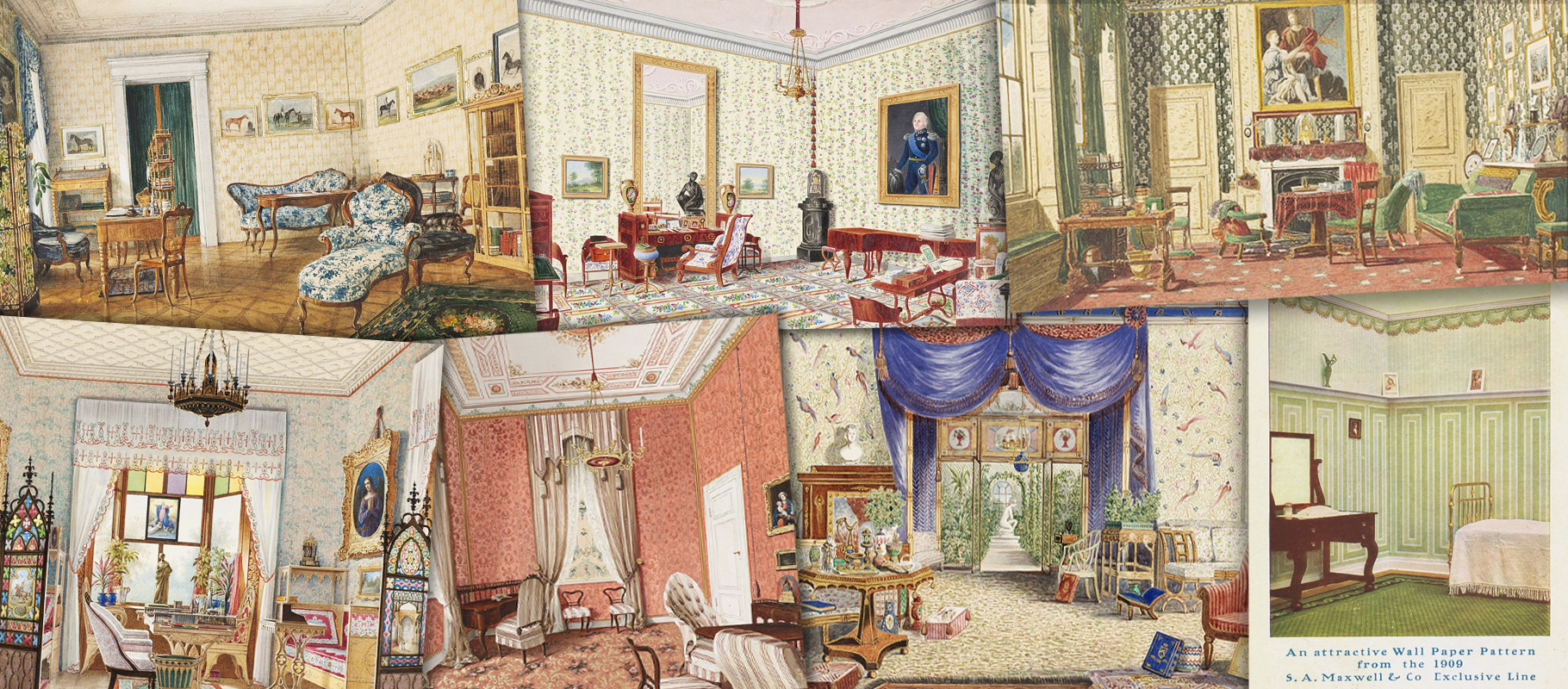 Above: various wallpapered interiors in historic houses
Above: various wallpapered interiors in historic houses Above: fragments of wallpaper from the 18th and 19th centuries
Above: fragments of wallpaper from the 18th and 19th centuries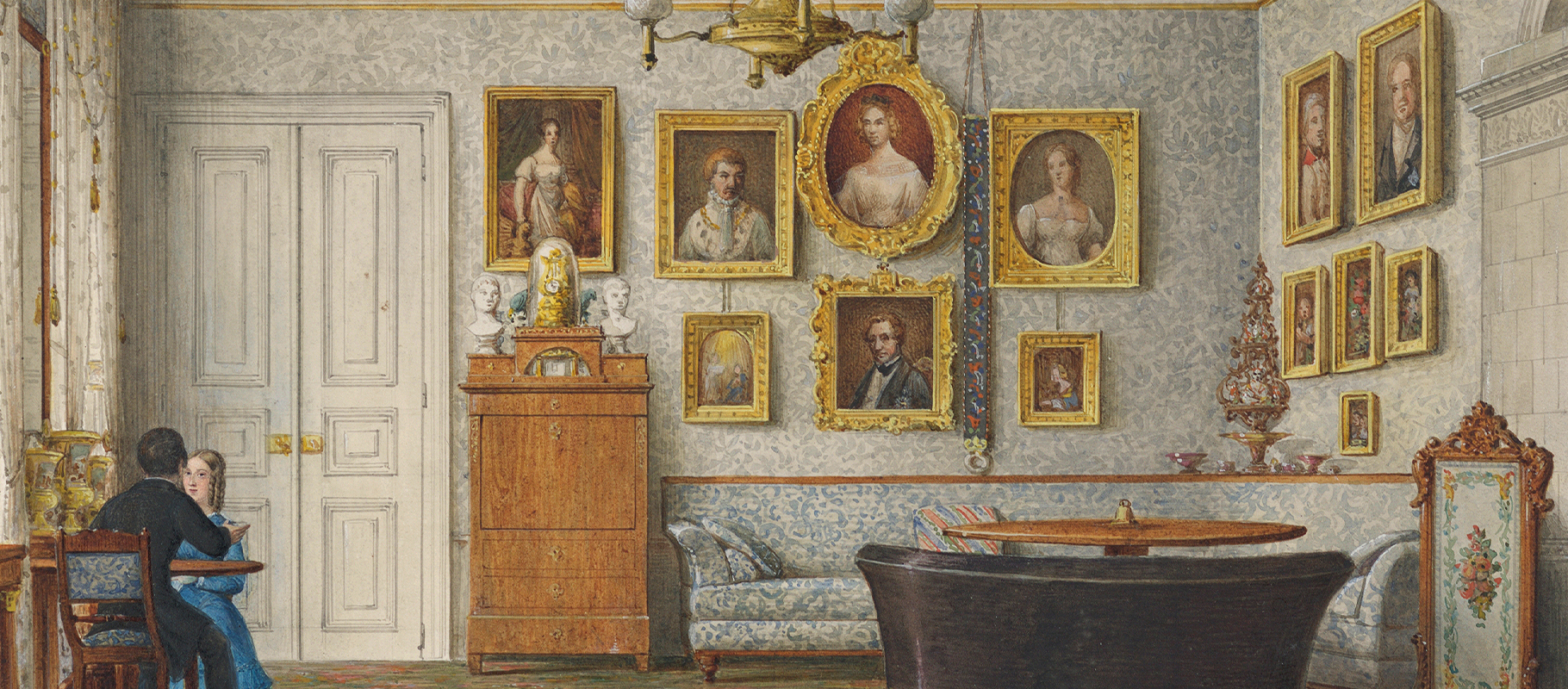 Above: a mid 19th century interior with papered walls
Above: a mid 19th century interior with papered walls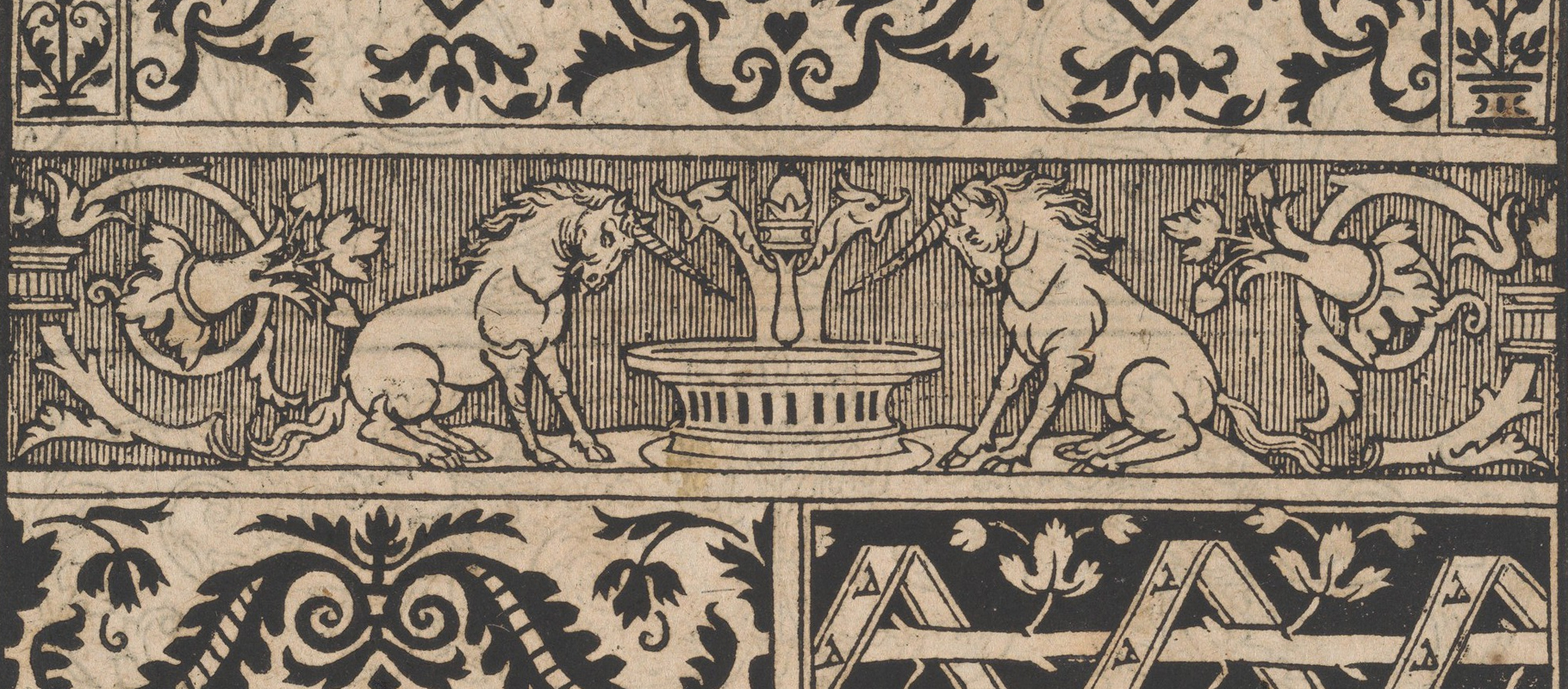 Above: designs from a 16th century pattern book by Matteo da Treviso, 1532
Above: designs from a 16th century pattern book by Matteo da Treviso, 1532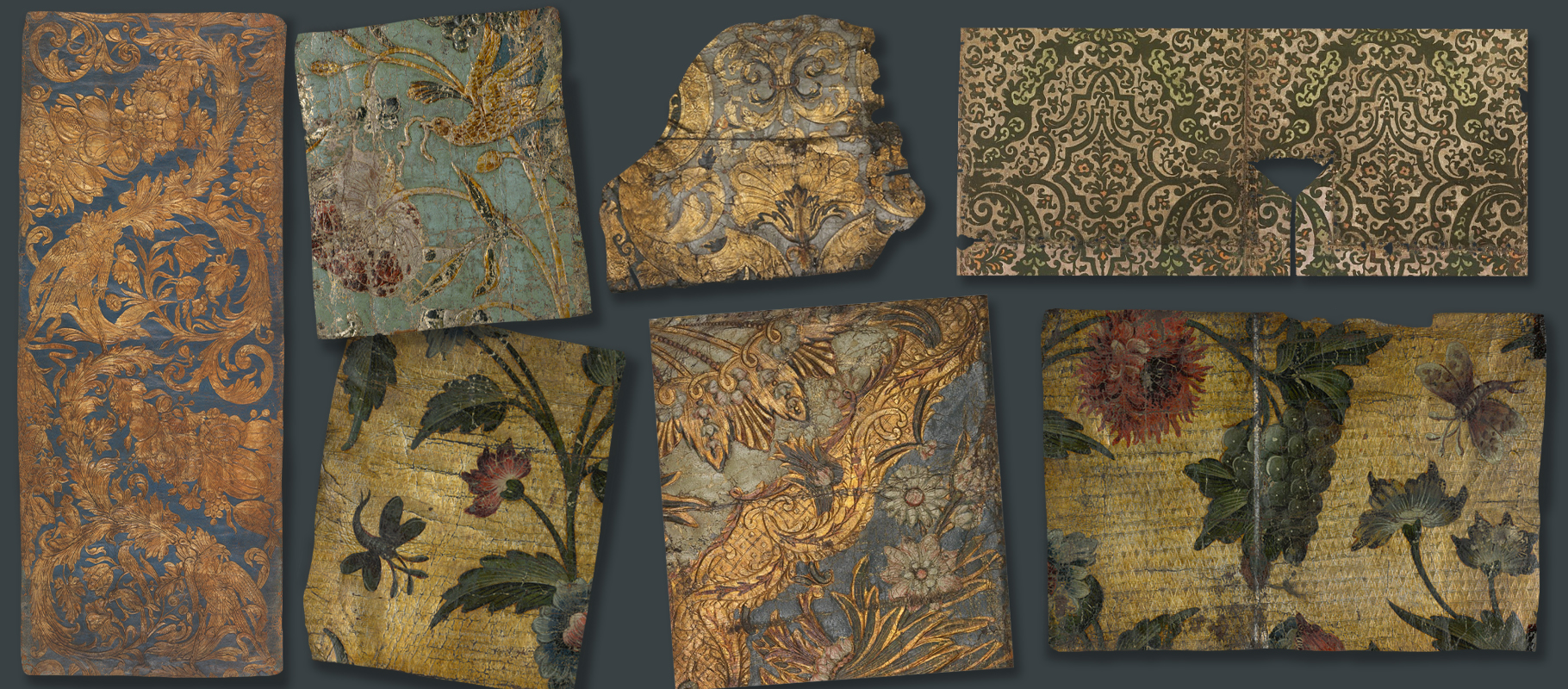 Above: a selection of 17th century and early 18th century wall coverings
Above: a selection of 17th century and early 18th century wall coverings 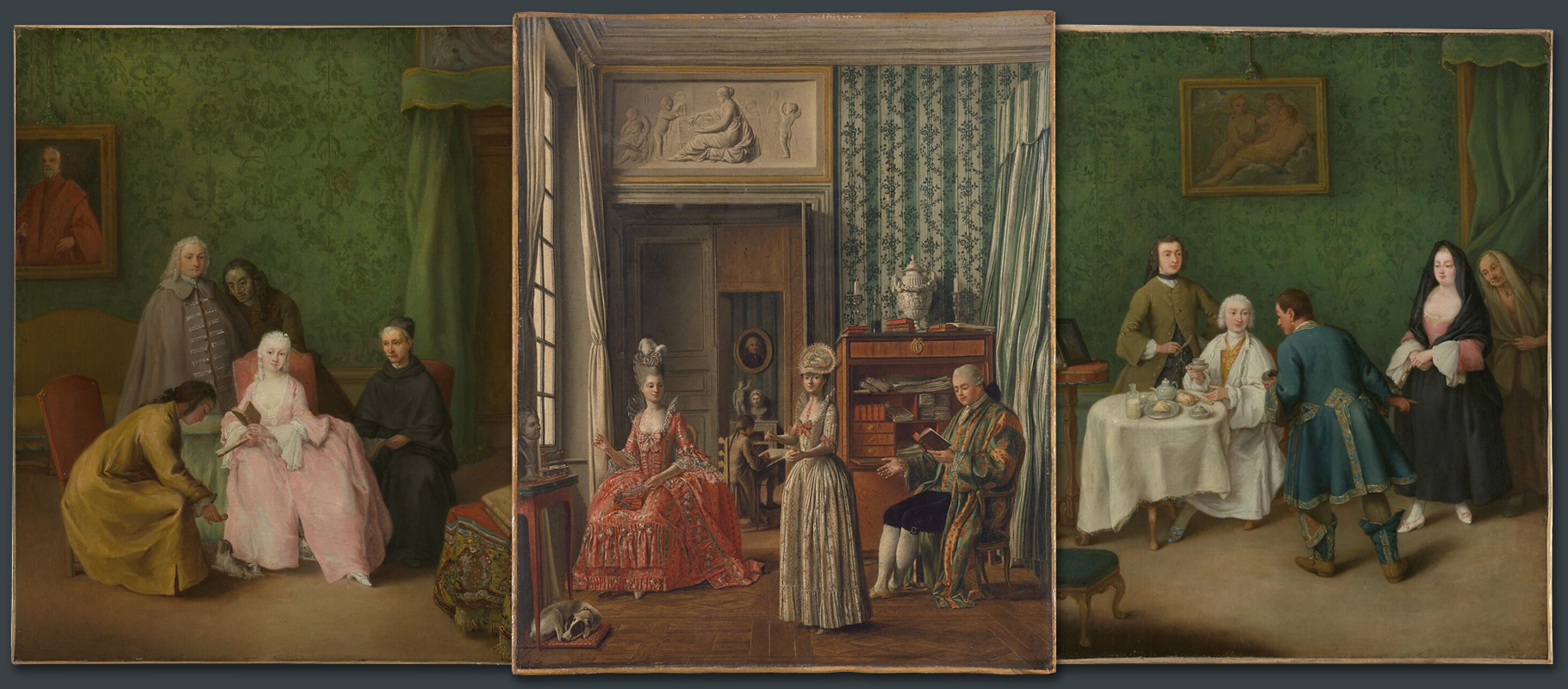 Above: oil paintings depicting 18th century interiors, these wall designs would have been printed on paper or textiles
Above: oil paintings depicting 18th century interiors, these wall designs would have been printed on paper or textiles Above: a room from the Powel House in Philadelphia, remodelled with Chinoiserie wallpaper in 1769-71
Above: a room from the Powel House in Philadelphia, remodelled with Chinoiserie wallpaper in 1769-71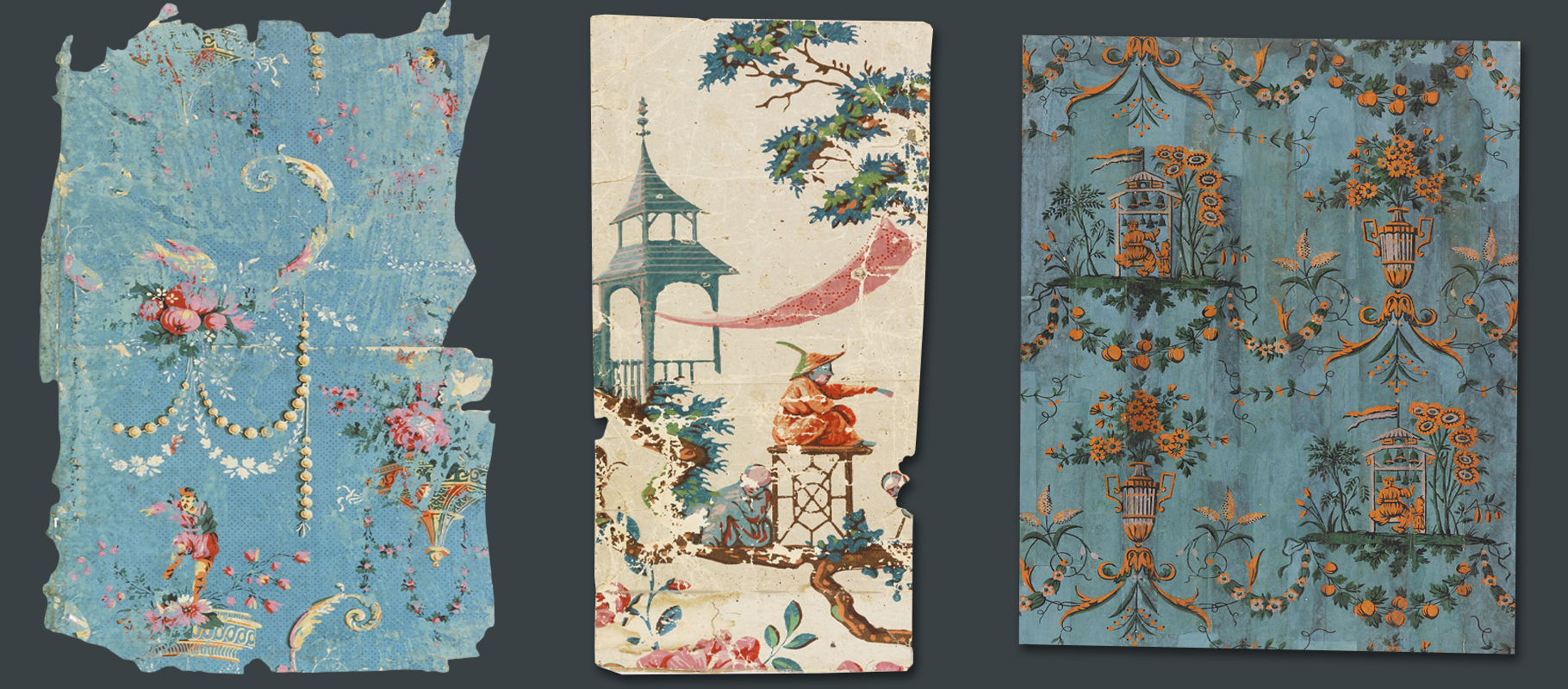 Above: three rococo wallpapers with designs inspired by Asian art
Above: three rococo wallpapers with designs inspired by Asian art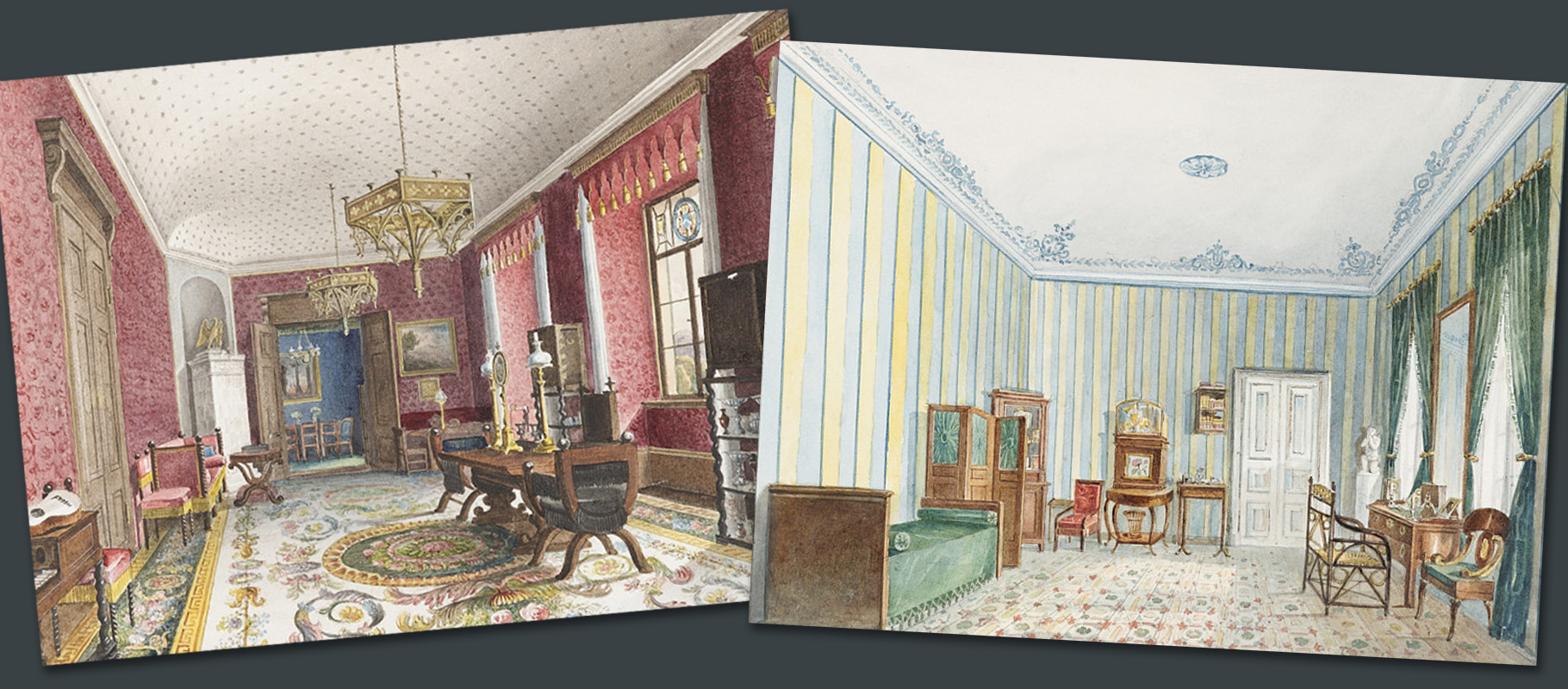 Above: two 19th century rooms with wallpaper decoration
Above: two 19th century rooms with wallpaper decoration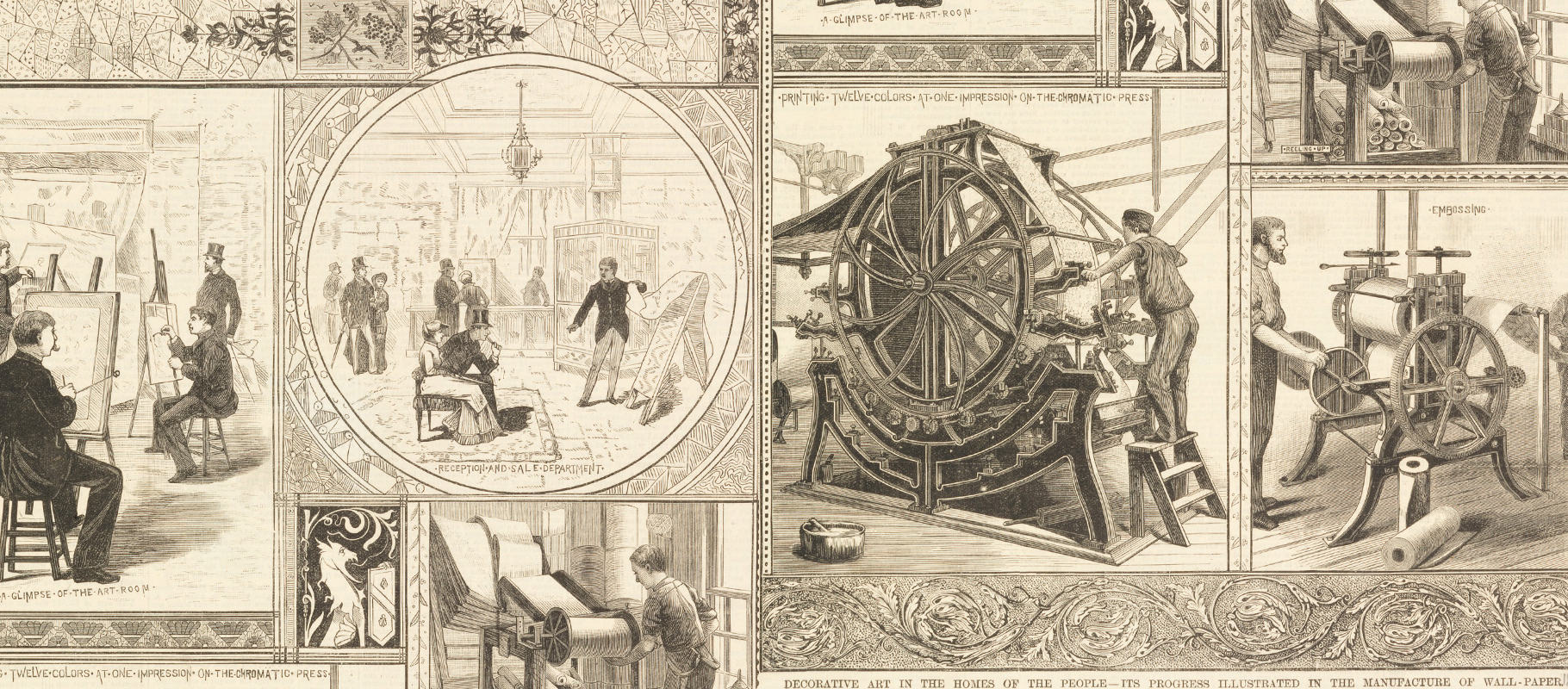 Above: an illustration showing the process of wallpaper production, 1882
Above: an illustration showing the process of wallpaper production, 1882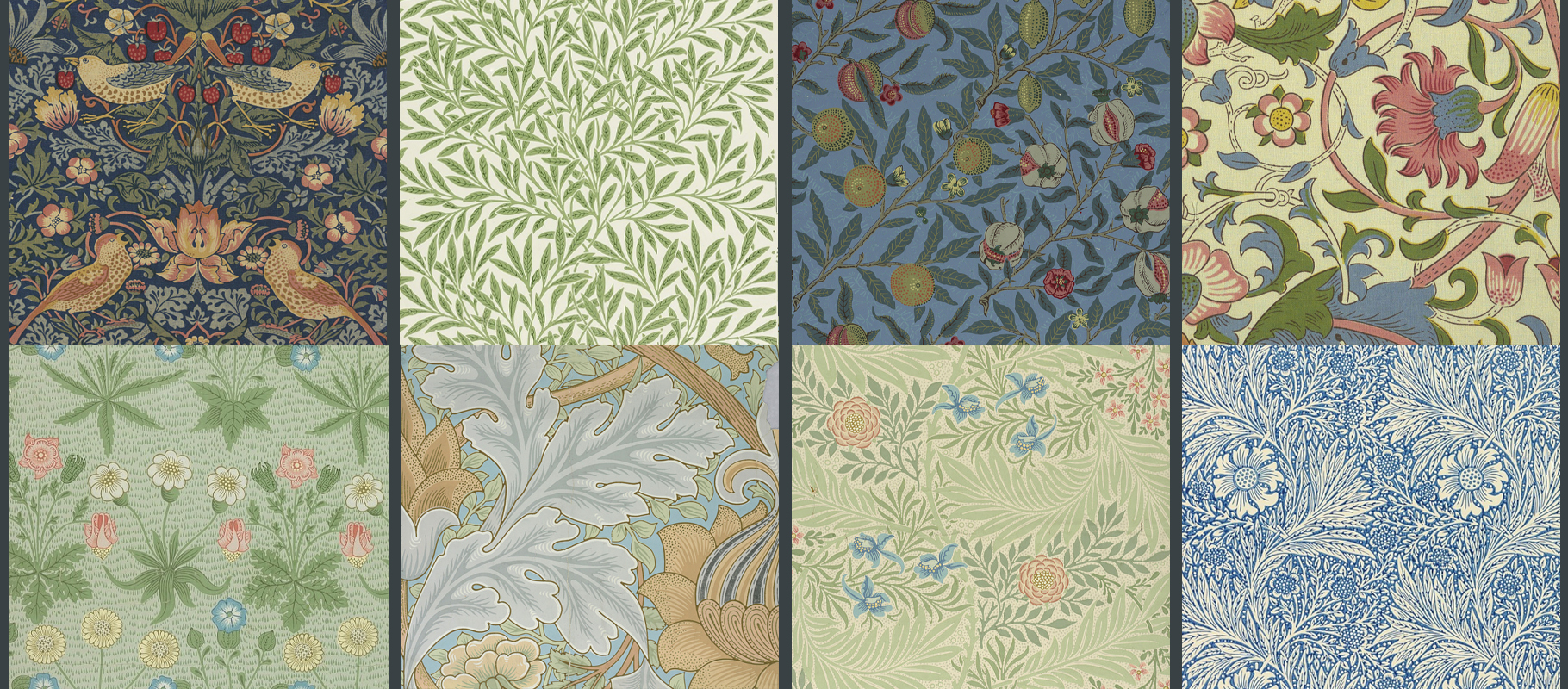 Above: various wallpaper designs from the studio of William Morris
Above: various wallpaper designs from the studio of William Morris Above: detail of an early 20th century wallpaper
Above: detail of an early 20th century wallpaper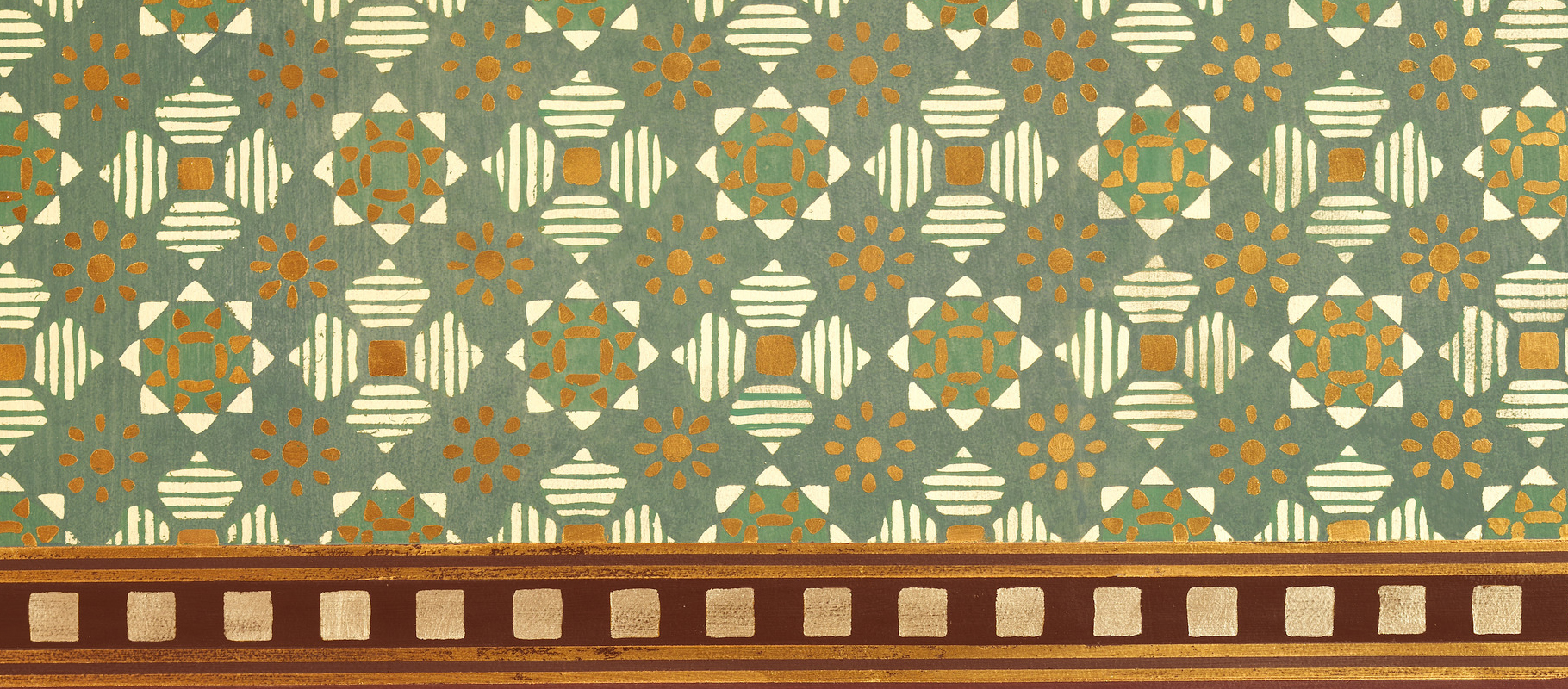 Above: wallpaper dated to 1881-82
Above: wallpaper dated to 1881-82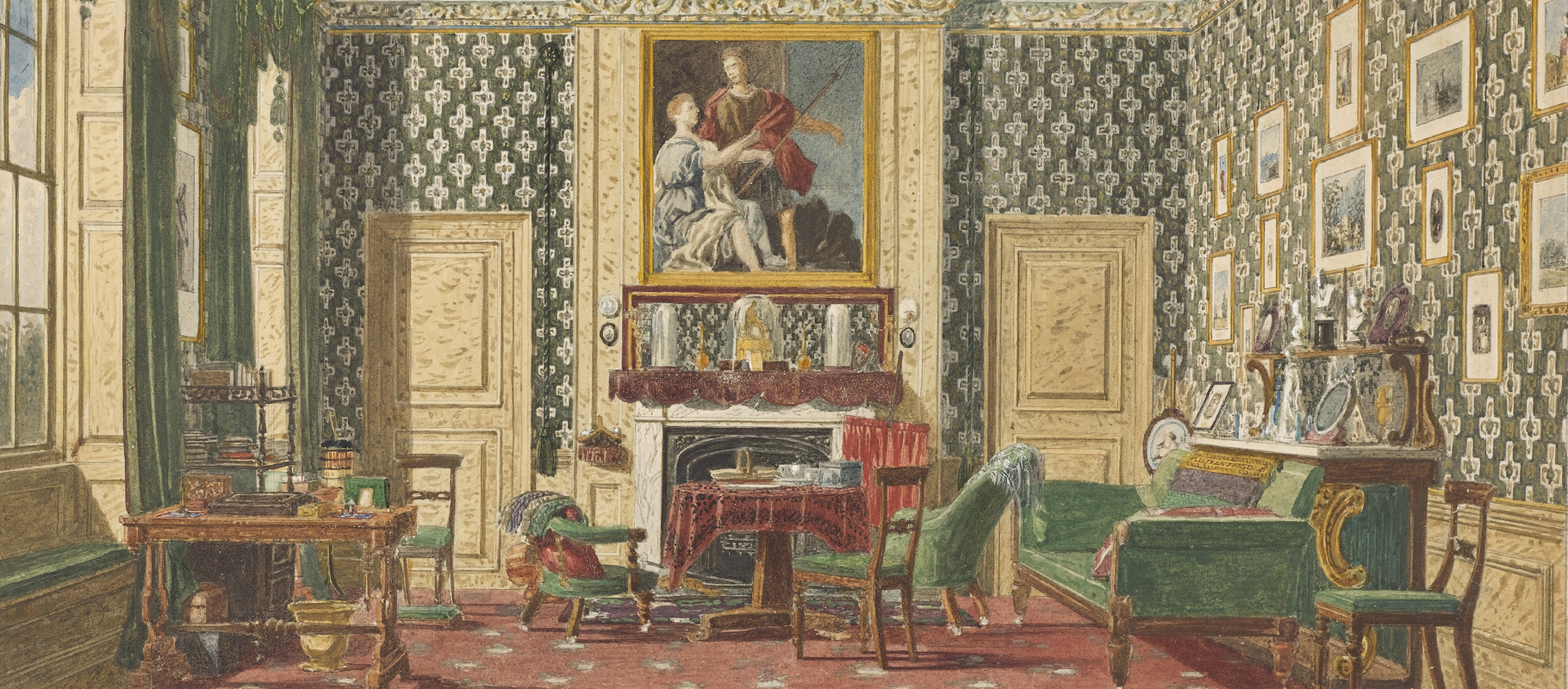 Above: watercolour painting of a Victorian interior
Above: watercolour painting of a Victorian interior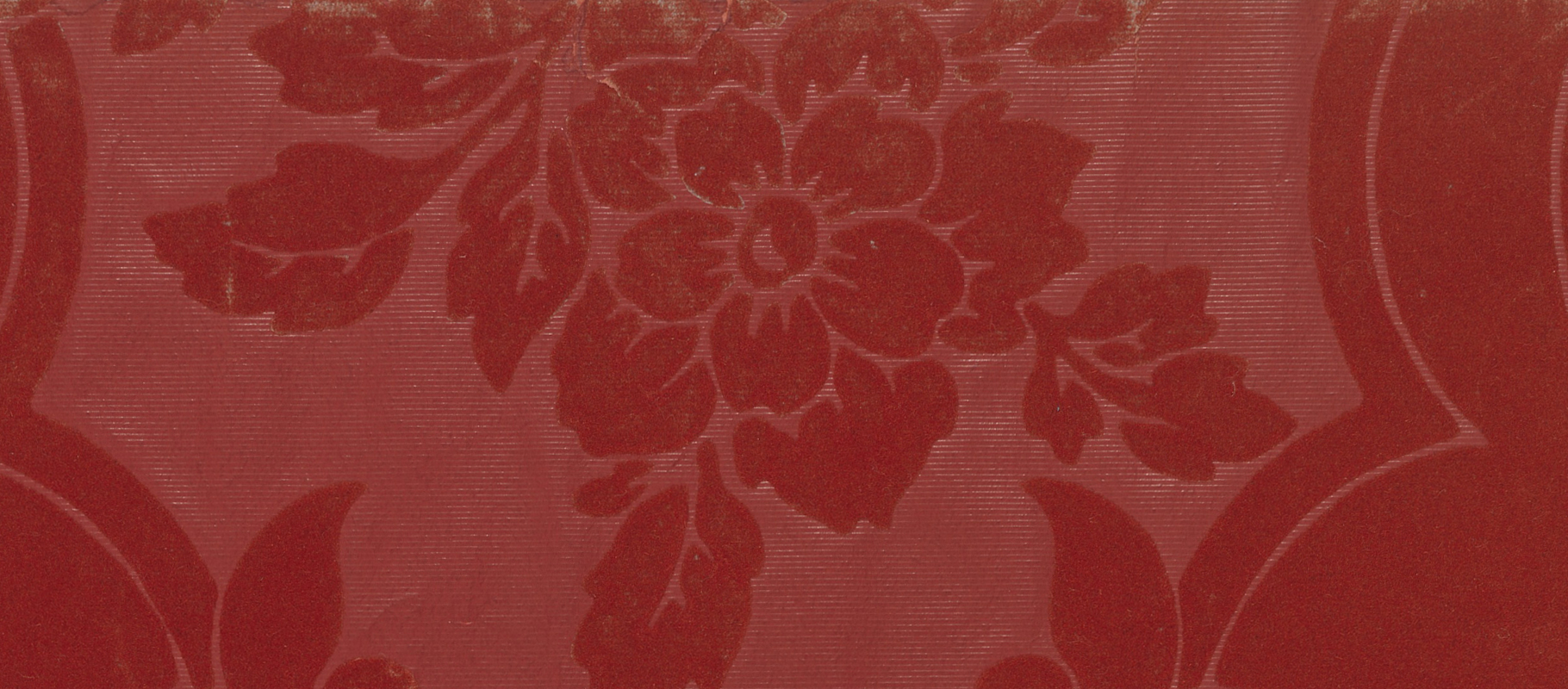 Above: detail of flocked wallpaper from 1920
Above: detail of flocked wallpaper from 1920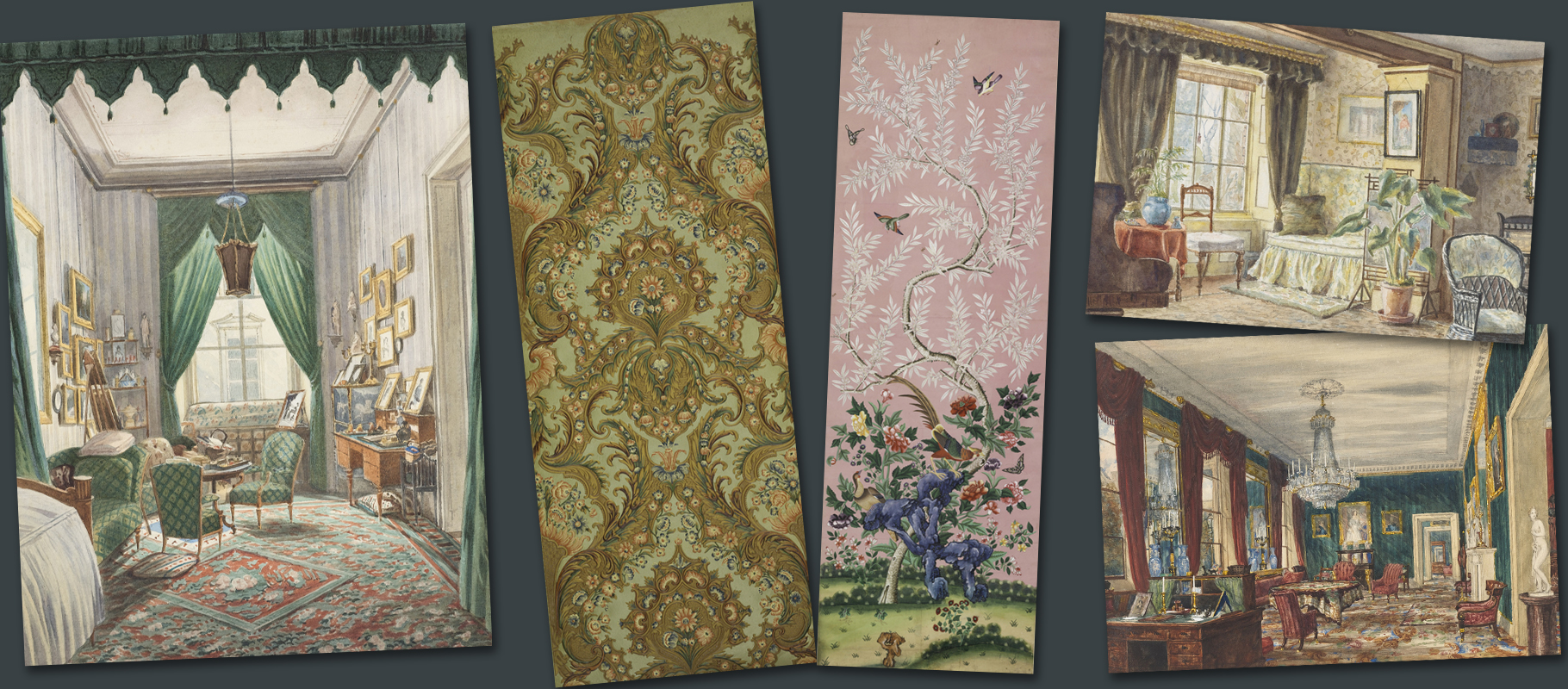 Above: a selection of 19th century wallpapers and interior designs
Above: a selection of 19th century wallpapers and interior designs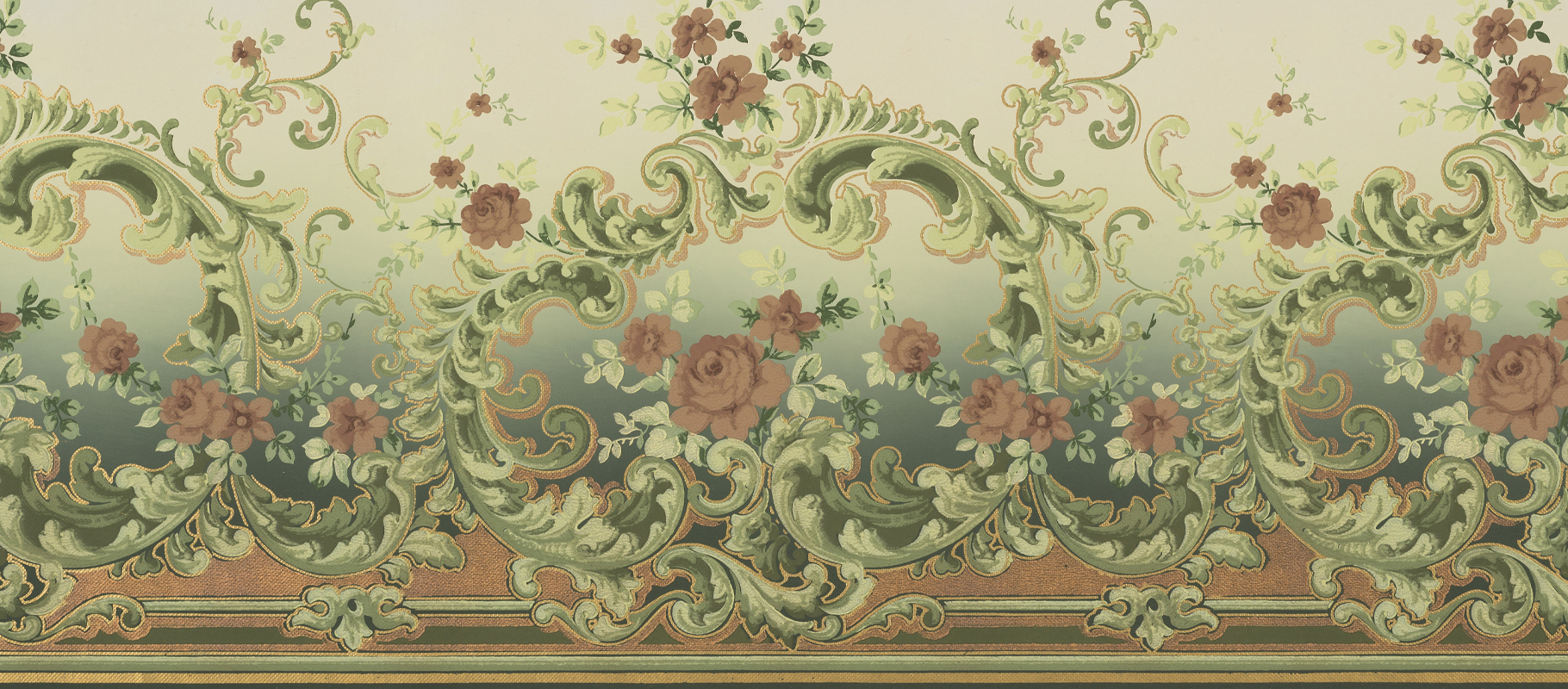 Above: a wallpaper frieze dated 1905-1915
Above: a wallpaper frieze dated 1905-1915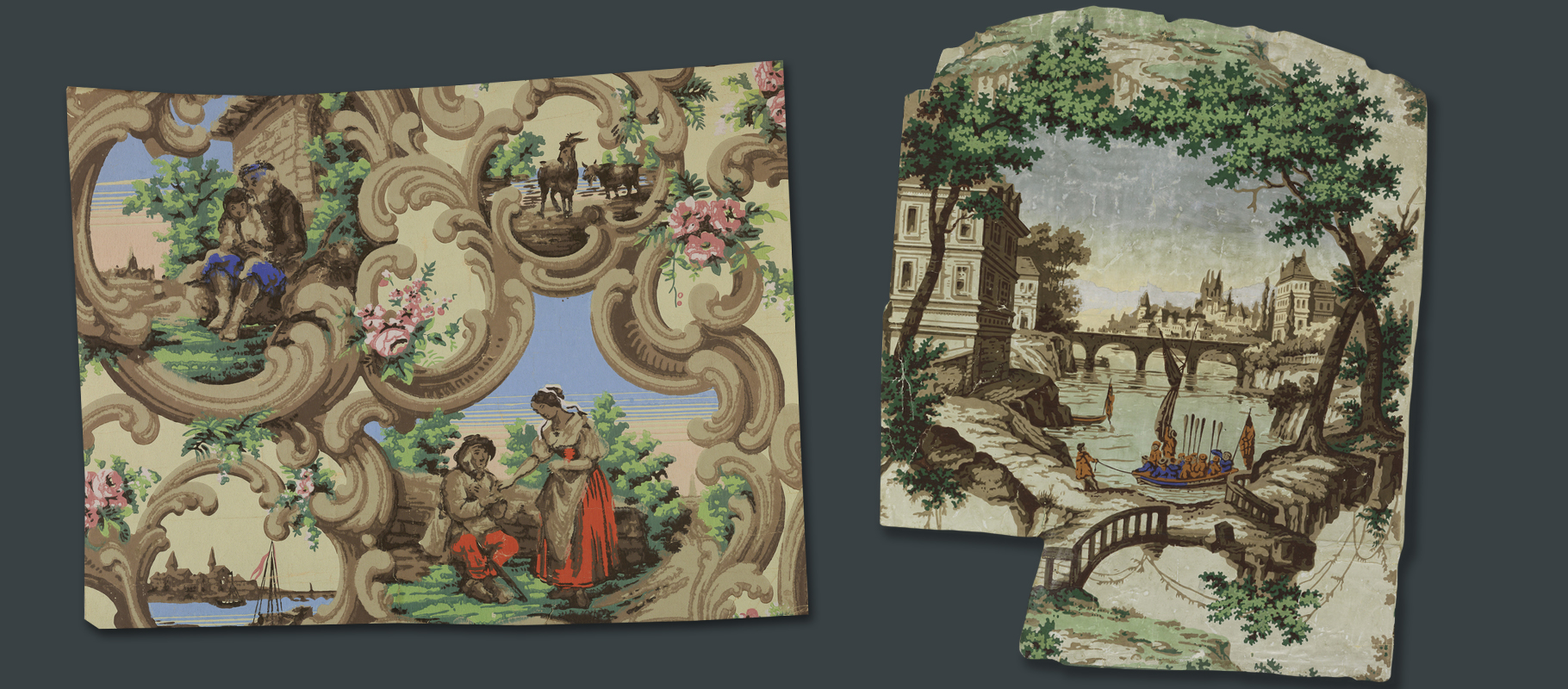 Above: fragments of mid 19th century wallpaper
Above: fragments of mid 19th century wallpaper Above: detail from a neoclassical wallpaper panel that has darkened with age, 1790
Above: detail from a neoclassical wallpaper panel that has darkened with age, 1790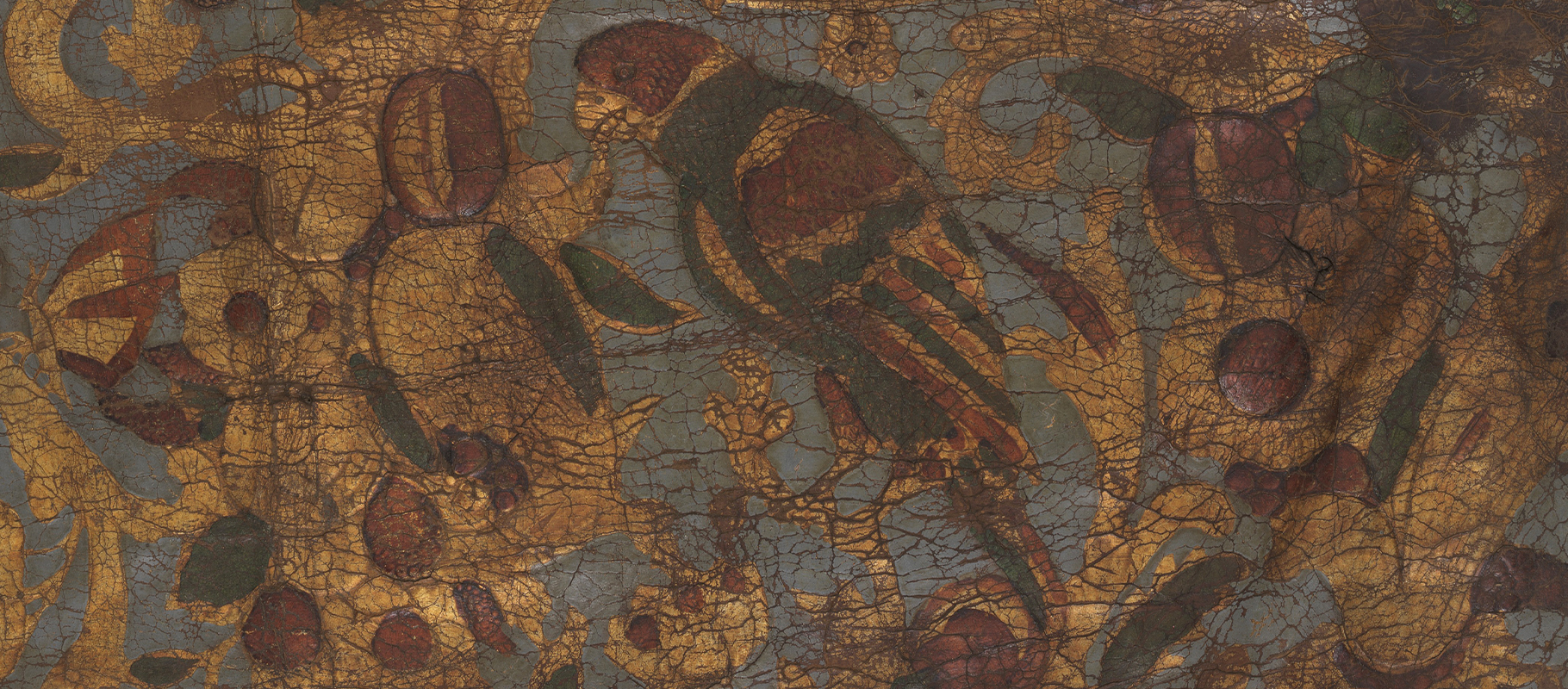 Above: a fragment of 18th century wallpaper
Above: a fragment of 18th century wallpaper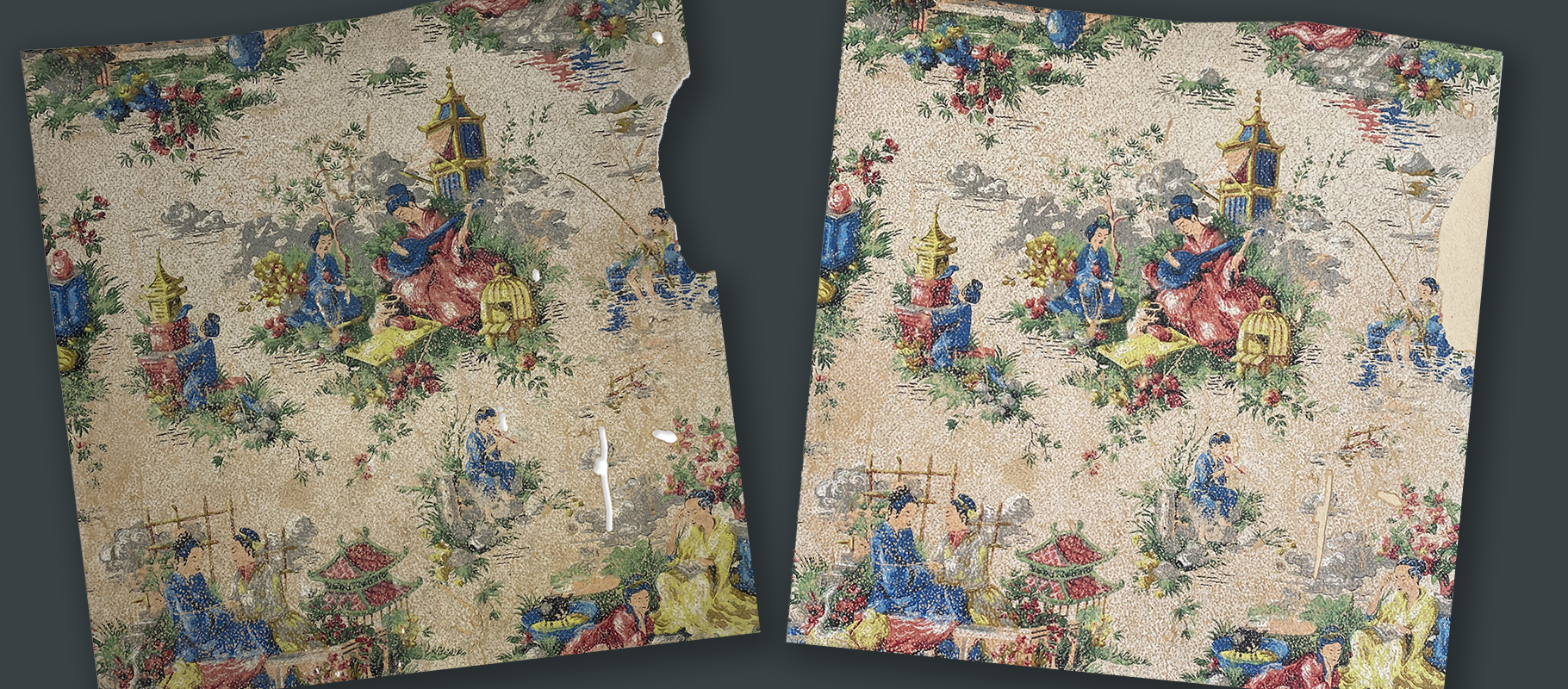 Above: a wallpaper fragment, before and after conservation by our team
Above: a wallpaper fragment, before and after conservation by our team




